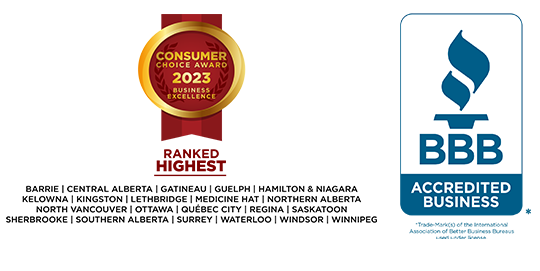Four ways a Licensed Insolvency Trustee can help you resolve your debt
Many people struggling with debt avoid contacting a Licensed Insolvency Trustee because they’re not sure they qualify for Bankruptcy — or because it’s a solution they want to avoid. That’s okay. We know Bankruptcy isn’t right for everyone. But that’s no reason not to give us a call.
At MNP, our Licensed Insolvency Trustees offer a Free Confidential Consultation for anyone struggling with problem debt who wants to know their options. We can help you understand your financial situation, explain all the options available to you and connect you with the right resources to achieve your financial goals.
Following are four ways we can help you resolve your debt:

Bankruptcy
If you owe $1,000 or more and cannot afford to pay your debts as they become due, Bankruptcy may be one option a Licensed Insolvency Trustee recommends to help you get a financial fresh start.
Here’s how the process works:
When you file a Bankruptcy, you will have to disclose all your outstanding debts, income sources, and assets (i.e., property) to the Licensed Insolvency Trustee (LIT). The LIT will use this information to determine what (if any) assets, and how much of your monthly income (if any) you must surrender for the general benefit of your creditors.
Once the LIT files your Bankruptcy application with the government, an automatic stay of proceedings goes into place. Your creditors cannot contact you and all wage garnishments and legal judgements against you are lifted.
You will have to submit monthly income and expense reports for the duration of your Bankruptcy. The LIT will use this information to calculate whether you have an increase in income which requires you to make payments (i.e., surplus income payments) into your Bankruptcy. You will also attend two mandatory financial counselling sessions as part of the Bankruptcy process.
For a first time Bankruptcy without surplus income payments, the process will typically last nine months — with surplus income payments, the process will typically last 21 months. Second or additional Bankruptcies will typically last 24 months without surplus income payments and 36 months with surplus income payments.
A Bankruptcy registers as R9 on your credit report for six years after your discharge. A second or additional Bankruptcy will revive the first Bankruptcy on your credit report, and both will remain for 14 years after your discharge.
Consumer Proposal
If you owe $1,000 or more — and less than $250,000 other than the mortgage on your principal residence — and cannot afford to repay your debts as they become due, a Licensed Insolvency Trustee may recommend a Consumer Proposal as a favourable alternative to Bankruptcy.
Two reasons why you may prefer to file a Consumer Proposal over a Bankruptcy include:
- You have assets you wish to keep which you would otherwise have to surrender in a Bankruptcy
- You wish to start rebuilding your credit right away
Here’s how the process works:
The LIT will review your unsecured debts as well as your monthly income and expenses. They will use this information to make a budget-appropriate, interest-free settlement offer to your creditors. This may:
- Reduce the total amount you owe (sometime by more than half),
- Extend the timeline you need to repay your debts (to a maximum of five years),
- Or both.
A majority by dollar value ($1 owed = one vote) of your unsecured creditors must vote in favour of a Consumer Proposal. Once a Consumer Proposal is accepted, it becomes legally binding on all your unsecured creditors. Like Bankruptcy, a stay of proceedings goes into place barring your creditors from contacting you and lifting any existing collections action (e.g., wage garnishments) against you.
There are two main options to repay your Consumer Proposal:
- A monthly payment to the LIT over a period of up to five years.
- A single lump sum payment to the LIT for the total settlement amount.
Like Bankruptcy, a requirement of filing a Consumer Proposal is that you attend two mandatory financial counselling sessions. Unlike a Bankruptcy, a Consumer Proposal will register as R7 on your credit report for three years after you made your final proposal payment.
Debt management program
If you don’t qualify for a Bankruptcy or Consumer Proposal — or if you and the Licensed Insolvency Trustee agree neither is the right solution for you — a debt management program may be another option. While Licensed Insolvency Trustees don’t directly offer this option, they can refer you to a reputable non-profit credit counselor who will arrange and manage the process on your behalf.
Here’s how the process works:
A non-profit credit counselor will negotiate with your creditors to reduce or eliminate the interest owing on your unsecured debts. If your lenders agree, you will make a single monthly payment to the credit counselor for up to five years, which they would distribute to your creditors on your behalf.
Ideally, this agreement will continue until you have repaid your debts in full. However, it is not legally binding. Some creditors may choose not to participate in a debt management plan, and those that do may choose to stop participating at any time. It also does not prevent creditors from calling you or pursuing other collections action such as a court judgement or wage garnishment.
Like a Consumer Proposal, a debt management plan will register as R7 on your credit report.
Consolidation
If you’re able to recognize and seek help for your debt problems early enough, it may be possible to address the situation relatively painlessly and with very little damage to your credit. When you meet with a Licensed Insolvency Trustee for a Free Confidential Consultation, they can indicate whether you’d be a good candidate for a consolidation loan.
Here’s how the process works:
First, you sit down to make a list of all the unsecured debts you owe (e.g., credit cards, lines of credit, personal loans, etc.). Beside those debts note the total amount outstanding and the interest rate. Add these amounts together and calculate the average of your interest rates.
Next, you visit a bank or other lender and fill out a consolidation loan application (note: you may want to shop around a little bit for the best rate and loan terms). The lender will review your credit history and inform you whether you qualify for a loan, how much they’re willing to offer, what interest rate they’re willing to charge.
If the lender is willing to offer a consolidation loan equal to your total unsecured debt, and the interest rate is less than the average you’re already paying, you could use this loan to pay off all your debts. Instead of keeping track of several monthly payments, you’d only need to make a single payment each month. And you’d pay less in interest — making it easier to pay off your debt faster.
Two words of caution:
- It might be advisable to cancel or suspend any credit cards, etc. that you pay off with your consolidation loan until the loan is paid off. It’s easy to start spending on credit again and making your debt situation even worse than it was before.
- Do not pay off any debts with a lower interest rate than the consolidation loan — e.g., personal loan of 8 percent versus a consolidation loan of 10 percent. You will end up paying more than you otherwise would have by keeping the debt separate.
A consolidation loan will not reflect poorly on your credit report — but missing payments or making payments late will. Before you take on a consolidation loan, first make sure you can afford it.
Budgeting assistance and advice
For some people, the problem isn’t that they can’t afford their living expenses and monthly debt repayments — they simply don’t have a solid financial plan to keep track of the money coming in and going out of their accounts.
It’s no exaggeration to say a regular and consistent budgeting practice can be absolutely life changing. Like any new habit, it can take some getting used to. But with practice, it will soon feel like second nature.
Licensed Insolvency Trustees are more than happy to provide you with plenty of great resources to build your budgeting skills. They can also refer you to some great budgeting coaches in your area who can provide more comprehensive guidance and support as you build your skills.
You always have options
No matter the debt problem, there’s always a solution and an opportunity for a financial fresh start. Don’t wait until your situation becomes unmanageable. Licensed Insolvency Trustees are here to help you understand your options and point you in the right direction.

